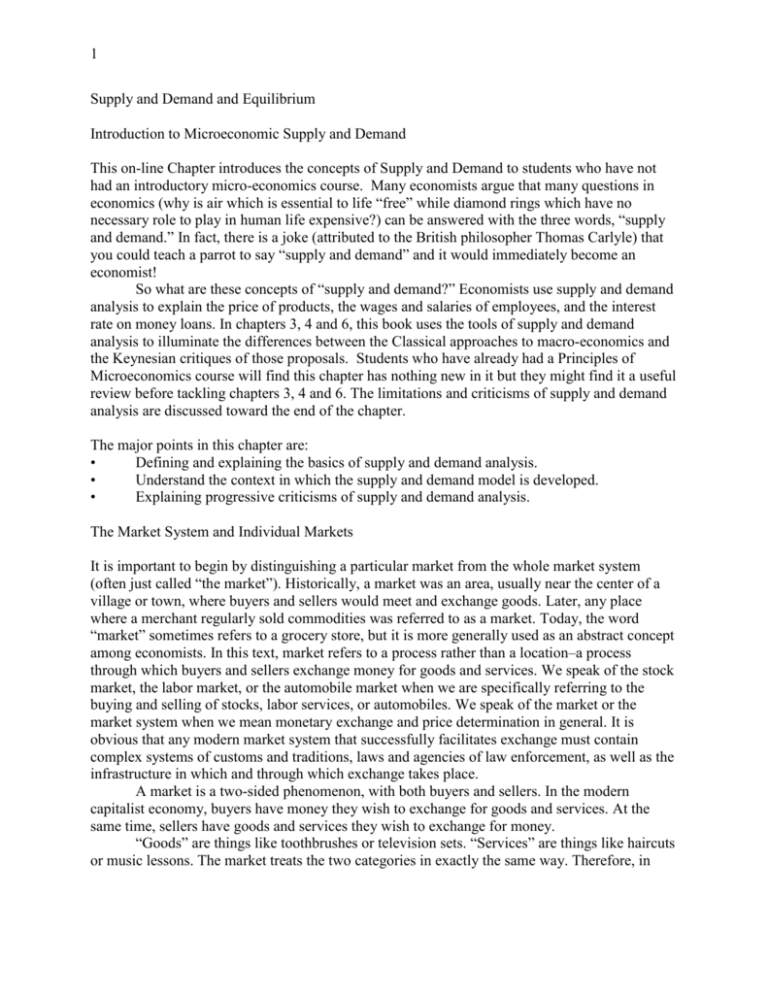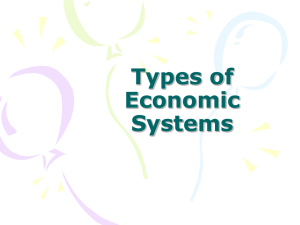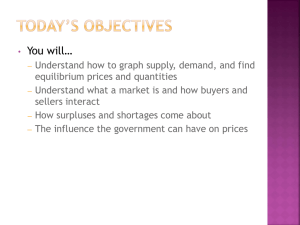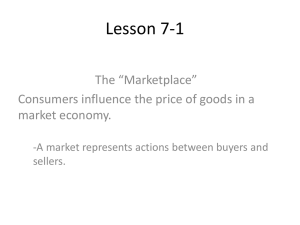Supply and Demand and Equilibrium
advertisement

1 Supply and Demand and Equilibrium Introduction to Microeconomic Supply and Demand This on-line Chapter introduces the concepts of Supply and Demand to students who have not had an introductory micro-economics course. Many economists argue that many questions in economics (why is air which is essential to life “free” while diamond rings which have no necessary role to play in human life expensive?) can be answered with the three words, “supply and demand.” In fact, there is a joke (attributed to the British philosopher Thomas Carlyle) that you could teach a parrot to say “supply and demand” and it would immediately become an economist! So what are these concepts of “supply and demand?” Economists use supply and demand analysis to explain the price of products, the wages and salaries of employees, and the interest rate on money loans. In chapters 3, 4 and 6, this book uses the tools of supply and demand analysis to illuminate the differences between the Classical approaches to macro-economics and the Keynesian critiques of those proposals. Students who have already had a Principles of Microeconomics course will find this chapter has nothing new in it but they might find it a useful review before tackling chapters 3, 4 and 6. The limitations and criticisms of supply and demand analysis are discussed toward the end of the chapter. The major points in this chapter are: • Defining and explaining the basics of supply and demand analysis. • Understand the context in which the supply and demand model is developed. • Explaining progressive criticisms of supply and demand analysis. The Market System and Individual Markets It is important to begin by distinguishing a particular market from the whole market system (often just called “the market”). Historically, a market was an area, usually near the center of a village or town, where buyers and sellers would meet and exchange goods. Later, any place where a merchant regularly sold commodities was referred to as a market. Today, the word “market” sometimes refers to a grocery store, but it is more generally used as an abstract concept among economists. In this text, market refers to a process rather than a location–a process through which buyers and sellers exchange money for goods and services. We speak of the stock market, the labor market, or the automobile market when we are specifically referring to the buying and selling of stocks, labor services, or automobiles. We speak of the market or the market system when we mean monetary exchange and price determination in general. It is obvious that any modern market system that successfully facilitates exchange must contain complex systems of customs and traditions, laws and agencies of law enforcement, as well as the infrastructure in which and through which exchange takes place. A market is a two-sided phenomenon, with both buyers and sellers. In the modern capitalist economy, buyers have money they wish to exchange for goods and services. At the same time, sellers have goods and services they wish to exchange for money. “Goods” are things like toothbrushes or television sets. “Services” are things like haircuts or music lessons. The market treats the two categories in exactly the same way. Therefore, in 2 what follows here, we shall use “goods,” but keep in mind that the argument is just the same for services. The amount of a good that buyers want to buy and have the money to purchase at any given price is called the “demand” for that good. Similarly, the amount of the good that sellers are willing and able to sell at any given price is called the “supply” of the good. Note that demand is not simply related to need or desire. A penniless child longingly gazing through the window of a candy store adds nothing to the market demand for candy. Similarly, in the Great Depression of the 1930s, millions of people went hungry while tons of wheat and thousands of cattle and sheep were destroyed and wasted because of the lack of any market demand for these products. The problem, of course, was that, like the child at the candy store, the unemployed millions, had no money to exchange for the food they needed. Thus, demand involves the combination of wants plus cash. Similarly, supply requires not just the willingness to sell a product but that actual possession of the product. Supply, Demand, and Prices Restated more formally, the definitions of demand and supply are as follows. Demand for a good is the quantity of that good buyers would be willing and able to purchase during a given period, at various price levels, holding all other things constant. We can think of it as a series of “if…., then…” statements: “If the price if $X, then I will buy Y quantity,” in the mind of the consumer before he/she actually arrives at the point where he/she can actually buy it. Obviously, demand must be expressed in terms of a given period if it is to have any meaning. The number of automobiles people wish to purchase is certainly very different over the course of a week than over a year. Moreover, a given price must be specified. Clearly, the number of automobiles people would like to buy will be very different if the price is $500 than if it is $50,000. The lower the price, the more of them people will be able to and want to buy. It is also very important to understand that these alternative price-quantity combinations are internal to the consumer–they exist before the consumer sees the product and knows the possible price. The definition of supply is very similar to that of demand. Supply of a good is the quantity of the good sellers would like to sell during a given period, at various prices, holding all other things constant. In most circumstances, firms are willing to increase the quantity they produce if the market price increases. Again, supply can be described as a series of “if…., then…” statements: “If the price is $A, then I will offer for sale B quantity,” in the mind of the seller before he/she knows how many buyers there are for the product. When demand and supply are combined, they describe the market for a particular product. Students should note that as defined above, demand and supply are independent of each other. Beginning with these definitions, it becomes possible to define a demand schedule and a supply schedule. A “demand schedule” relates various prices of that good with the amounts of that good people would like to buy at each of the various prices. This schedule of demand by buyers takes as given the incomes and preferences of the buyers–as well as the prices of related goods like substitutes. If people in a particular state or region of the United States were polled in order to determine the number of automobiles, such as Ford Explorers, they would like to buy at various prices, the results might be similar to those given in Table SD1. <<Table SD1 Demand.doc GOES HERE>> At a price of $35,000, only 35,000 Ford Explorers will be purchased. If the price fell to $15,000, then the quantity demanded would increase to 55,000 Ford Explorers. The information 3 contained in this demand schedule is illustrated in Figure SD1 as a demand curve. This demand curve, D, illustrates graphically the relationship between prices and the quantity demanded. It can be used to ascertain the quantity of Ford Explorers that buyers would be willing and able to purchase at any given price. The analysis of demand in Table SD1 is made clearer by looking at Figure SD1. <<Fig SD1 demand, tiff GOES HERE>> This figure shows that the demand for Ford Explorer automobiles declines as prices rise. The next section explains the details of such a graph. How to Read a Graph Some graphs are very simple. Suppose we want to show how many home runs were hit every year in a ten year period. The bottom or horizontal axis may show each year from 2000 to 2009 at equal points along that axis. The side or vertical axis will show the number of homeruns. Similarly, a graph could show the number of nurses graduated from 2000 through 2009. Every student should try making a simple graph like this. Then the mystery will disappear. If we apply this knowledge to Figure SD1, the horizontal axis shows the number of Ford Explorers that are estimated to be bought at every price level. The vertical axis shows the price of the Ford Explorer. Thus, we may show a series of points showing how many Ford Explorers will sell at each price level. By running a solid line through all of the points, we get the downward sloping demand schedule shown in the table and in the figure (graph and figure mean the same thing here). Why the Demand Schedule Looks This Way Why does the demand curve usually have a downward slope? Because the law of demand says there is an inverse relationship between price and quantity demanded. The law of demand says that as the price of a good falls, the quantity demanded increases, ceteris paribus (holding everything else constant). Similarly, as the price of a good rises, the quantity demanded of the good decreases, ceteris paribus. But what explains this “law of demand”? At higher prices, the quantity demanded is smaller both because other goods or substitutes appear relatively more attractive and because people simply do not have enough income to buy as much at those higher prices. As prices decline, the quantity demanded increases both because people can afford more and because these goods are now relatively cheaper compared to other alternatives than they were before. In a similar manner, a supply schedule expresses the number of Ford Explorers (amount of a good) the Ford Motor Company (the seller) would desire to sell at various prices. Table SD2 summarizes this hypothetical information. <<Table SD2 SUPPLY SCEDULE GOES HERE>> One picture is worth a thousand numbers, so the data is also shown in Figure SD2. <<Fig SD2 SUPPLY SCHEDULE GOES HERE>> In this case, if the market price were $15,000, Ford would be willing to produce only 35,000 Explorers. However, if the price increased to $35,000, Ford would be willing to increase its quantity supplied to 55,000 of these vehicles. In Figure SD2. , this same information is expressed graphically in the form of a supply curve, demonstrating the quantities sellers would like to sell at various prices. 4 Why does the supply curve usually slope upward? Because the law of supply declares that a positive relationship exists between price and the quantity supplied of any good. The law of supply says that as price increases, the quantity supplied of goods increases, all other things being equal. Similarly, as the price of a good falls, its quantity supplied falls, ceteris paribus. Ford is in business for profit. At higher prices (assuming input prices do not change), it can make more profit, so it is willing to increase the quantity supplied of Explorers only when prices are higher. Market prices are determined jointly by the forces of both supply and demand. Notice that since suppliers and demanders are different people, the two schedules behind the two curves are independent of each other. That means that before the consumers know what is available in the market, they have these alternative price-quantity combinations in mind. Similarly, sellers base their supply offerings on elements internal to their business without knowing in advance what consumers will do. Sellers wish to exchange products for money, and buyers wish to exchange money for products. When a particular price is established, a specific quantity will be offered for sale and a specific quantity will be demanded. If these two quantities are equal, both sellers and buyers may conduct transactions in the desired quantities. For example, in Figure SD1, the demand curve for Explorers in Figure SD2 is superimposed on the supply curve used in Figure 1.3. It is clear that if a price of $25,000 is established, the point at which the curves intersect indicates that buyers and sellers want to buy and sell 45,000 Explorers. The behavior of supply and demand are illustrated together in Figure SD3. <<Fig SD3 SUPPLY AND DEMAND GOES HERE>> When the quantity supplied and the quantity demanded for a particular good are equal at a particular price, the market is said to be in equilibrium. At equilibrium price, everyone is able to buy or sell all that they choose to buy or sell within their budget. For those who like a strict technical definition, “equilibrium” is defined in general as a situation from which there is no tendency to move, given the terms of the analysis. When we specifically define an equilibrium price we state that when the quantity supplied and the quantity demanded for a particular good are equal at a particular price, the market is said to be in equilibrium. At equilibrium price, everyone is able to buy or sell all that they choose to buy or sell within their budget. The more general reference to the “terms of the analysis” means that if income, or preferences, or the price of some other related good were to change, there would be a new demand curve. If costs of inputs or technology were to change, there would be a new supply curve. One other aspect of this concept of equilibrium is that at prices above or below equilibrium price there is a tendency to move–and that tendency is to move towards the equilibrium price. At a price above equilibrium, suppliers offer many more products than consumers are willing and able to purchase. The result is that suppliers are left with a surplus. As they recognize the existence of this surplus, they quickly cut the price but also scale back production. That decline in price induces more consumers to purchase that product. Thus the tendency for any price above equilibrium is for it to fall until it reaches equilibrium. A somewhat similar process occurs at a price below equilibrium. A shortage develops which encourages producers to expand production and raise the price. Limitations of Supply and Demand Analysis 5 While supply and demand analysis is useful for some tasks, it has many limitations that make it far less useful than it at first appears. First of all, it is assumed that all prices move freely to adjust supply and demand. It is also assumed that there are thousands of buyers and thousands of competitive sellers in every market. But suppose that there is only one seller. For example, suppose that Microsoft has no competitors in selling Windows. When Microsoft sets a price on Windows, buyers may scream and cry, but usually they can either buy at that price or go without it. In other words, if one or a few firms have some monopoly power in the market, then supply and demand does not work as it is supposed to work. It only works if there are a very large number of buyers and sellers in every market, but that is a false assumption. In fact, in most industries in the United States, production is concentrated in just a few firms with great market power. Information is not perfect. There are also government controls over some markets. For example, the market for medicines must be controlled to assure consumer safety. Any set of controls changes the market working of supply and demand. Moreover, a perfectly working capitalist market requires that every individual and every firm have perfect knowledge of what is going on, including the specifications of every product and the price of every product in every store. Consumers and enterprises have very poor knowledge of many facts, and the same information is not easily available to everyone. In most markets, business owners cannot easily move from one industry to another. Therefore, the prices in most industries are very far from the results that supply and demand in a perfectly competitive market would predict. Only agriculture still has tens of thousands of firms, but agricultural prices are often determined by government subsidies and controls. We used the example of the Ford Explorer because it was a well-known commodity on the market that most people have seen and can picture. It is actually, however, a poor example of the mechanics of supply and demand because it is definitely not the product of a perfectly competitive industry. There are only a relatively small number of automobile producers who control most of the supply of SUVs. Ford is one of the giants, so it has a certain degree of power to manipulate prices differently than a firm in an imaginary competitive industry. Moreover, all buyers of automobiles know that their knowledge is limited. In such an industry, the price of the Ford Explorer is far different than it would be under perfect competition. Why did we not choose a famous product from some industry that has pure and perfect competition? There are none! Usually textbooks use some agricultural product like class A corn but most agricultural products are heavily influenced by government activity. The final problem with the traditional analysis is that nobody has ever seen a supply or demand curve outside of a book. They are supposedly internal to the consumers and producers before they actually attempt to buy or sell. All that we actually see are a series of prices at different dates, accompanied by a series of quantities sold at those dates. These are obviously the result of the intersections of many demand and supply curves. We could graph those points, but if we ran a line through all of them, it would wander all over the page. Is that line a supply curve? Is it a demand curve? Did demand stay the same while new supply curves appeared each time? Did supply remain the same while new demand curves appeared each time? In the real world, it is often difficult to determine whether it was a change in demand or a change in supply that caused price and quantity to change. Students must remember that supply and demand is simply one lens through which we view the world and attempt to understand, explain, and make predictions. Don’t confuse the supply and demand lens with the real world 6 itself. Always remember that supply and demand curves are imaginary constructions that some economists think may be useful to understand how prices of goods and services are determined. Others use different approaches. KEY TERMS demand supply demand schedule supply schedule equilibrium









